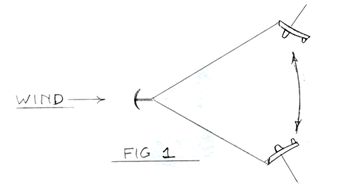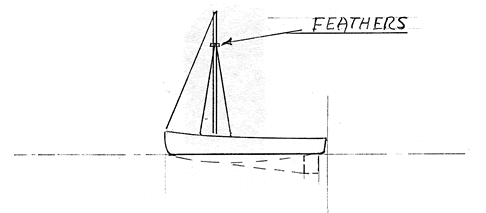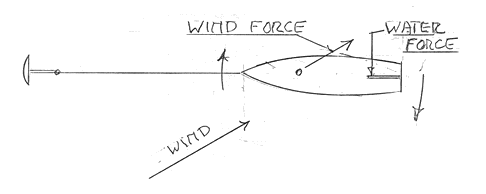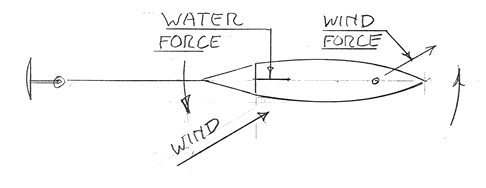The following section has generated little interest so far.. I even mentioned it to a couple of Marine insurance companies to no avail.
However, I finally picked the following up on the web.
"Have you ever tried anchoring from the stem? I anchored the other weekend for an experiment in 20 to 30 knots out in the open. The difference between how our Seraph 25D behaves stem to as opposed to bow to was utterly amazing. Sure we had wave slap and some spray into the cockpit, but she just sat there and pointed into the wind with every shift. By the bow she dances around like a drunken ballerina, sailing off one way, snatching up on the anchor line, turns, and off she goes the other way. The anchor sail on the backstay helped but she still wasn't nearly as composed as when her stem was facing the waves. Mr. Jordan will tell you why this works. And more importantly maybe, why sailing vessels USED to be able to get away with bow anchoring and why modem sloops just can't ;without sailing all over the place."
MOORING
AND ANCHORING
In the fall
of 2004, four hurricanes devastated southern Florida.
"Hurricane Ivan struck the Gulf Coast causing extensive damage.
Insured U.S. losses exceeded $7 billion". Science News, April
05. The media showed scenes of marinas with a shambles of damaged
boats. Boats from moorings and anchors littered the shore.
"Yachting
World, -- Nov. 1996, Hurricane Bertha, British Virgin Islands,
Moorings are vulnerable in the wind. It is particularly unnerving
to watch the yachts tacking back and forth and blowing flat at
the end of each tack, Chafing is one the biggest enemies of hurricane
survival" See Fig 1.

The research
which led to the design of the series drogue, and even more important,
the actual experience at sea with a variety of yacht designs,
and with storm encounters up to hurricane strength, can provide
another benefit to the yachting community.
These engineering
data clearly show that, in storm conditions, a sailing yacht should
be moored or anchored from the stern with a bridle, not the bow.
If moored from the stern, the boat will lie quietly and will weathercock
with changes in the wind direction.
The design
loads for the mooring or anchor can then be estimated with sufficient
accuracy to permit the design of a reliable mooring system for
hurricane winds. There is no technical reason why a sailing yacht
need break away from a mooring. The wild and destructive motion
shown in Fig. 1 is caused by a form of dynamic instability which
is now well understood. Similar unfortunate behavior was experienced
on early aircraft designed to fly at high speed. Now known as
flutter, the wing would twist and oscillate up and down with increasing
amplitude until failure occurred. A similar but more widely publicized
event was the failure of "Galloping Gerty" the Seattle Tacoma
suspension bridge, which undulated in the wind until one day,
in a heavy gale, the vibrations grew so severe that the bridge
broke into pieces.
Not all boats
become dynamically unstable when tethered from the bow in a strong
wind. However modern sloop rigged yachts with a cutaway forefoot,
short keel and spade rudder are particularly vulnerable. Such
designs make up a large share of the yachting communities. A schooner
rigged yacht with a long straight keel is better, and most of
the old gaff rigged schooners would ride fairly well. Power boats
are often better than sailing yachts. However, boats with a high
bow and a large structure forward can do poorly. All designs would
be more secure anchored-from the stern.
Fifteen years
at sea with the series drogue has demonstrated that a yacht will
not be "pooped", and the rudder and companionway doors will not
be damaged by mooring from the stern. The cockpit may occasionally
fill from waves slopping aboard.
The Stability
of Anchored or Moored Sailing Yachts
If an anchored sailing yacht is stable it will lie quietly. If
it is unstable it will develop a violent motion under high wind
conditions. An object is said to be stable if, when a force is
applied to deflect the object, an opposing force is generated
to return the object to the original course. All moving vehicles,
boats, cars, bicycles, airplanes, etc. are designed to be stable
when moving forward. Otherwise it would not be possible to steer
them in a straight line. If a vehicle is stable moving forward,
it will be unstable moving backward.
The most familiar
example of an object with positive directional stability is an
arrow.

An arrow is
highly stable moving forward
If deflected from its course, the feathers act to bring it back.

If an arrow
is tethered at the arrowhead end and exposed to a strong wind
it will be stable and will lie quietly, aligned to the wind.

If the arrow
is tethered at the feather end, it will be unstable and will flail
around wildly.

The motion
of an arrow is influenced only by air forces. However, the motion
of a sailing yacht is influenced by both air forces and by water
forces. All sailing yachts are designed to be stable when moving
forward through the water. Therefore, they will automatically
be unstable when moving backward through the water, as any skipper
who attempts to steer the boat backward will attest. The boat
will yaw.
Hurricane Ike on a Stern Mooring – 2008 New Information
By great good fortune we have a detailed description of the behavior of a sailing yacht moored from the stem in Hurricane Ike in the Gulf, as reported by a brave and competent sailor who stayed aboard for the whole event. Hurricane Ike was a major storm that damaged oil rigs and devastated a large area along the shore. This certainly was a "worst case" mooring event. The boat was a Hunter 376 sloop rigged yacht, length 37 ft. 6 in. displacement 15000 lb. The hull has an open, walk through, transom. The bottom of the stern is relatively flat, and rests a couple of inches above the water and "slaps" when the boat is at anchor. The mast is high.
The boat was anchored very securely with 300 ft. of scope to the first anchor and 200 ft. to a large second anchor, plus chain ahead of the anchors. The anchors did not move during the storm. The depth was 20 to 30 ft. and the fetch was a third of a mile.
The skipper reports:
"As the waves got bigger they filled the cockpit halfway up the companionway doors. I could see water going over the cabin at the mast.
The wave slap turned to pounding as the waves grew higher. The boat jerked forward as each wave pounded the stern. I could see the mast shake with every wave...The stem did not lift with the waves and the boat did not pitch.
The bilge pump failed and the bilge filled. I thought I was going to sink the boat. I managed to fix the pump and rig a second pump and got the water back down."
This is certainly a frightening story. I have considered all aspects and believe that I understand why this happened, and what we can learn to avoid such a problem in the future.
The skipper suggested that the heavy pull on the anchor line was holding the stem down. This cannot be the problem. With 200 ft of line to the first anchor the slope of the anchor line is relatively shallow and if the load had been 2000 lbs, a high estimate, the vertical component of the load would only be about 200 lbs, not nearly enough to hold the stern from rising..
Under these extreme hurricane conditions, this behavior is what might be reasonably expected. This was a major storm. Small houses along the shore were tipped on their sides or completely destroyed...A wind speed of 110 mph was reported.
The boat did not yaw, roll or pitch.
Wave theory indicates that a wave train of 6 ft. near breaking waves formed over a reasonable fetch would have a wave speed of 15 ft. / second and a period of 3 seconds. The skipper reported that the stern did not rise to the waves. Also be mentioned that every time a wave struck the mast shook. This is a significant observation.
A large boat with a high mast has high inertia and resists sudden pitching movement. The mast is a major contributor, as it takes a large force to wave the mast in a fore and aft direction rapidly.
Every boat has a natural frequency in pitch. If the natural frequency is much lower than the wave frequency the boat will not respond. This boat has a low natural frequency in pitch and could not rise to the rapid 3 second wave strikes.
The skipper was understandably traumatized by this experience. He felt he had made a mistake by mooring the boat from the stern. Actually, the boat behaved well, it did not roll or yaw violently as is a common experience in a storm such as this.
The flooding problem was serious, and was certainly aggravated by the open transom. However it is probable that some water would get over a conventional transom in these conditions.
The "pounding" of the waves under the flat transom should not be damaging.
This event tells us that in preparing a boat for a hurricane or severe storm, it would be prudent to tape up all sources of leakage from the cockpit and the deck. In this instance it seems that the companionway doors may have been the main source of the leakage.
It should be noted here that the drogue has been through many storms at sea including several of hurricane strength and there are no reports of the cockpit filling. The reason for this is that the waves at sea are large and have a low frequency. The boat has time to rise with the wave.
Water Forces:

When
sailing forward, the keel and the rudder act as the feathers on
the arrow. When under sail, the air forces on the sails and rigging
are balanced so that the loads on the tiller are minimized, and
the air forces do not have an important effect on the directional
stability. The boat will hold the desired course with little control
from the skipper.
Air Forces:

However, and
this is a critical point, when the boat is at anchor and the sails
are down, the mast and rigging act as the feathers on the arrow.
Since the mast and rigging are located at the forward part of
the boat, ahead of the center of gravity, the boat will be unstable,
and will develop a violent motion in a strong wind such as a hurricane.
The force on the mast and rigging of a conventional 40 ft. sloop
will be approximate 800 lbs. in a 75 mph hurricane wind. When anchored
from the bow in a hurricane, the boat is, in effect, moving forward
through the air at a speed of 75 mph., a situation similar to
a boat on a trailer being towed at 75.
An Unstable
System:
A tethered boat will be unstable if, when the boat yaws due to
a wave strike or change in wind direction, forces will be created
which act to yaw the boat further. The boat will continue to yaw
until fetched up and brought about by the load from the tether.
The sketch below shows a boat tethered from the bow. A wind shift
of 30 degrees strikes the boat. The boat starts to move sideways.
The air force on the mast and rigging tends to move the bow further
away from the wind. The sideways motion also causes water loads
on the keel and rudder, which move the stern upwind, thus further
increasing the yaw

A Stable
System:
A tethered boat will be stable if, when the boat yaws, forces
will be created which act to reduce the yaw and return the boat
to the original course or, in this case, turn the boat into the
new wind direction. This sketch shows the boat tethered from the
stern. The air force on the mast and rigging now acts as the feathers
on the arrow and aligns the boat with the new wind. Also, the
water forces on the keel and rudder now act to align the boat
with the wind. The higher the wind and water forces the more firmly
the boat will be aligned. Many skippers have commented on how
aggressively the series drogue holds the stern into the wind and
waves in a storm at sea.

An Engineered
Design for Moorings:
To design a dependable mooring system it is necessary to establish
a reasonable maximum load, which will cover all anticipated storm
conditions. To my knowledge, this has never been done. Moorings
have evolved empirically over the years. If moored yachts are
unstable and sail back and forth, it is difficult to establish
the peak loads. The maximum load will occur when the yacht reaches
the end of the excursion and is blown flat. This load can obviously
be relatively high. The air loads can be high since the boat can
be broadside to the wind. In addition, the air loads can be greatly
augmented by dynamic or inertia loads as the boat is yanked to
a stop, blown flat, pivoted 180 degrees, and then accelerated
in the opposite direction.The most common form of failure is chafing
of the tether as the load goes from zero to maximum in one direction
and then from zero to maximum in the other direction. The transient
loads continue for hours during the course of the hurricane.
If the tethered
boat has adequate directional stability, and weathercocks into
the transient wind shifts, the maximum load on the mooring can
readily be predicted with acceptable accuracy for design purposes.
There will be no significant dynamic forces. The forces from the
4 to 6 f1.waves formed in the harbor by hurricane winds will generate
very low loads.
The primary
loads will come from the air loads on the hull and rigging caused
by the hurricane force winds. Fortunately, very complete data
on the aerodynamic drag of all reasonable objects are available
from testing in wind tunnels and other facilities. If we consider
a typical modem 40 ft. sloop rigged yacht in a hurricane rated
at 100 mph, we know from boundary layer measurements that the
velocity near the surface will be less then that of the main stream
because of friction with the water surface. The velocity near
the water surface will be about 60 mph and at the mast, 75 mph.
Under these conditions, the drag of the hull, facing stern to the
wind, will be about 300 to 400 lbs. and the drag of the mast and
rigging will be 700 to 800 lbs. We might use a conservative estimate
of 2000 lbs for design purposes. The breaking strength of a three
quarter inch nylon mooring line is 16,000 lbs.
Chafing should
be easily avoided when the load is relatively steady in magnitude
and direction. There is no technical reason why a mooring should
fail in a hurricane. In fact, a properly designed mooring may
well be the safest haven for a sailing yacht in a hurricane, far
safer than a crowded marina or a quickly chosen "hurricane hole.
To conclude
this discussion, we might ask why, over the thousands of years
of sailing experience, did not sailors realize that a sailing
yacht should be moored from the stern, not the bow. The answer
lies in the difference between the design of traditional vessels
from the age of sail and the design of modem sailing yachts. Traditional
vessels had a long straight keel running all the way to the stern.
The rudder was small and did not extend below the keel. They were
mostly schooner or square rigged, arid they were heavy and deep
in the water. The resultant wind force on the masts and rigging
was aft of the center of the boat. As a result, they came about
slowly and often with some difficulty.
Conversely,
modern yachts have a short deep keel and a cutaway forefoot. They
also have a powerful rudder and are light in weight. The single
mast is tall and is located ahead of the center of the boat. These
features are necessary to obtain good upwind performance and agility
when coming about. However, they make the boat highly unstable
when tethered from the bow in a strong wind. Fortunately, the
more unstable a boat is when tethered from the bow, the more stable
it will be when tethered from the stern. Fifteen yours of experience
with the series drogue tethered at the stern has demonstrated
that, with hurricane force winds and even when buffeted by large
breaking storm waves, the boat will ride quietly and will quickly
adjust to wind shifts and random wave strikes.
There can
be little doubt that a proper stern mooring would have saved many
of the moored boats that were destroyed in the four hurricanes
that struck Florida in the fall of 2004.

